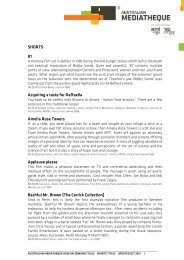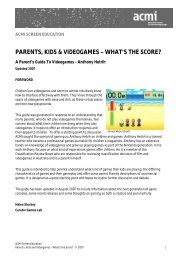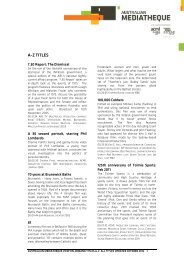Tim Burton's Gothic Imagination
Tim Burton's Gothic Imagination
Tim Burton's Gothic Imagination
You also want an ePaper? Increase the reach of your titles
YUMPU automatically turns print PDFs into web optimized ePapers that Google loves.
TIM BURTON’S GOTHIC PLAYFULNESS AND<br />
CORPSE BRIDE (2005)<br />
The <strong>Gothic</strong> imagination is recognised for its fascination with the dark, unknown or<br />
unexplored side of human experience, but it is driven by a range of impulses, anxieties and<br />
fascinations. <strong>Gothic</strong> styles of perceiving and representing the world are underpinned by the<br />
inevitability of death, but while some <strong>Gothic</strong> texts represent death in terms of destruction<br />
and annihilation – the opposite of life – others seek to reconnect life and death as two halves<br />
of existence. Corpse Bride is very much focused on life and death as inextricably intertwined<br />
aspects of the human experience.<br />
It could be argued that most people who identify with the ‘Goth‘ subculture are attracted to<br />
its creative possibilities. Similarly, <strong>Tim</strong> Burton’s films disrupt the familiar surface reality of<br />
everyday life in order to explore other imaginative possibilities. For instance, in Beetlejuice,<br />
the Maitlands, a conventional couple, die and come face to face with an afterlife that is<br />
chaotic, unpredictable and funny. In The Nightmare Before Christmas, Jack Skellington and<br />
his Halloween Town friends are full of a crazy, disorderly energy that is completely out of<br />
place at Christmas time but is both funny and appealing. Edward Scissorhands comes down<br />
from his <strong>Gothic</strong> mansion and injects a heady combination of fantasy and creativity into the<br />
monotony of the suburban world he encounters before being expelled.<br />
Corpse Bride is Burton’s most complete exploration of the relationship between life and<br />
death and involves a particularly playful and positive representation of the idea of the<br />
afterlife. The story is taken from a folktale about a young man who accidentally puts his ring<br />
on the finger of a bride who has been murdered on her wedding day. In his adaptation of the<br />
story, Burton remains faithful to the basic narrative in which the young man is taken down<br />
into the underworld where he must set things right before being reunited with the living<br />
woman waiting to marry him. One of the outstanding features of Burton’s interpretation of<br />
the story is the gentle humour and compassion of his depiction of the Corpse Bride who is so<br />
pathetically delighted when the young man, Edward, inadvertently proposes to her.<br />
The Corpse Bride is very much in the tradition of the Burton outsider. In particular, she brings<br />
to mind the character of Edward Scissorhands. Like him she is incomplete, and lives in an inbetween<br />
world. These characters are also alike in their essential innocence and their desire<br />
for acceptance, a desire that only serves to emphasise their difference from everyone else.<br />
Just as Edward’s scissorhands are a constant reminder of his constructed ‘monstrous’ nature,<br />
the Corpse Bride’s rotting body highlights the disintegration and degeneration of death.<br />
Desperate to be the captivating girl she once was, the Corpse Bride treats decomposition as<br />
a social embarrassment best managed with decorum. The maggot that pops out of the<br />
Corpse Bride’s empty eye socket makes a mockery of the pretence that she still inhabits a<br />
world where appearances matter. However, rather than being shocking and horrible, the<br />
Corpse Bride’s determination to put herself back together when she comes apart, is both<br />
brave and optimistic, linking up with her pitiful pleasure in Edward’s accidental proposal.<br />
In the scene where Edward first encounters the Corpse Bride, Burton pulls out a multitude of<br />
the conventions associated with <strong>Gothic</strong> horror: a dark wood with trees towering overhead,<br />
FREE FOR EDUCATION Education Resources <strong>Tim</strong> Burton’s <strong>Gothic</strong> <strong>Imagination</strong> 29










